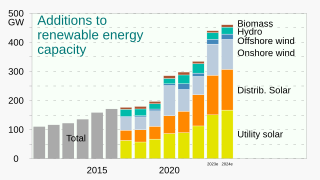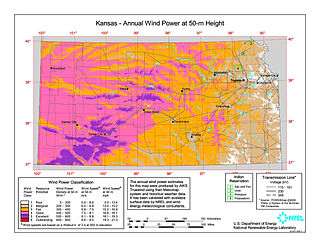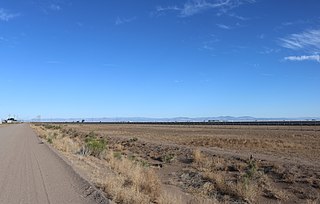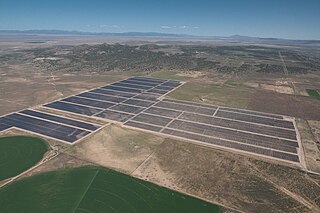
Renewable energy is energy that is collected from renewable resources that are naturally replenished on a human timescale. It includes sources such as sunlight, wind, rain, tides, waves, and geothermal heat. Although most renewable energy sources are sustainable, some are not. For example, some biomass sources are considered unsustainable at current rates of exploitation. Renewable energy often provides energy for electricity generation to a grid, air and water heating/cooling, and stand-alone power systems. About 20% of humans' global energy consumption is renewables, including almost 30% of electricity. About 7% of energy consumption is traditional biomass, but this is declining. Over 4% of energy consumption is heat energy from modern renewables, such as solar water heating, and over 6% electricity.

Energy development is the field of activities focused on obtaining sources of energy from natural resources. These activities include production of renewable, nuclear, and fossil fuel derived sources of energy, and for the recovery and reuse of energy that would otherwise be wasted. Energy conservation and efficiency measures reduce the demand for energy development, and can have benefits to society with improvements to environmental issues.
The Office of Energy Efficiency and Renewable Energy (EERE) is an office within the United States Department of Energy. Formed from other energy agencies after the 1973 energy crisis, EERE is led by the Assistant Secretary of Energy Efficiency and Renewable Energy, who is appointed by the President of the United States and confirmed by the U.S. Senate. Kelly Speakes-Backman was appointed Acting Assistant Secretary in January 2021.

Renewable energy commercialization involves the deployment of three generations of renewable energy technologies dating back more than 100 years. First-generation technologies, which are already mature and economically competitive, include biomass, hydroelectricity, geothermal power and heat. Second-generation technologies are market-ready and are being deployed at the present time; they include solar heating, photovoltaics, wind power, solar thermal power stations, and modern forms of bioenergy. Third-generation technologies require continued R&D efforts in order to make large contributions on a global scale and include advanced biomass gasification, hot-dry-rock geothermal power, and ocean energy. As of 2012, renewable energy accounts for about half of new nameplate electrical capacity installed and costs are continuing to fall.

The Ministry of New and Renewable Energy (MNRE) is a ministry of the Government of India, headed by current Union Cabinet Minister Raj Kumar Singh, that is mainly responsible for research and development, intellectual property protection, and international cooperation, promotion, and coordination in renewable energy sources such as wind power, small hydro, biogas, and solar power.

According to preliminary data from the US Energy Information Administration, renewable energy accounted for about 12.6% of total primary energy consumption and about 19.8% of the domestically produced electricity in the United States in 2020.

China is the world's leading country in electricity production from renewable energy sources, with over triple the generation of the second-ranking country, the United States. China's renewable energy sector is growing faster than its fossil fuels and nuclear power capacity, and is expected to contribute 43 percent of global renewable capacity growth. China's total renewable energy capacity exceeded 1,000GW in 2021, accounting for 43.5 per cent of the country's total power generation capacity, 10.2 percentage points higher than in 2015. The country aims to have 80 per cent of its total energy mix come from non-fossil fuel sources by 2060, and achieve a combined 1,200GW of solar and wind capacity by 2030.

Spain has set the target of generating 20% of all its energy needs from renewable energy sources by 2020 and an additional 0.8% may be available for other EU countries under the cooperation mechanism bringing the total to 20.8%. By the end of 2014 Spain had reached a level of 16.2% of all its energy needs from renewable energy sources.

The renewable-energy industry is the part of the energy industry focusing on new and appropriate renewable energy technologies. Investors worldwide have paid greater attention to this emerging industry in recent years. In many cases, this has translated into rapid renewable energy commercialization and considerable industry expansion. The wind power, solar power and hydroelectric power industries provide good examples of this.

In the U.S. State of Kansas, wind power is the largest source of electricity, generating over 41% of the state's electricity in 2019. Kansas has a high potential capacity for wind power, second behind Texas. The most recent estimates (2012) are that Kansas has a potential for 952 GW of wind power capacity yet had only about 5.6 GW installed by year end 2018. Kansas could generate 3,102 TW·h of electricity each year, which represents over 75% of all the electricity generated in the United States in 2011. This electricity could be worth $290 billion per year.

The US state of Colorado has vast wind energy resources and the installed electricity capacity and generation from wind power in Colorado has been growing significantly in recent years. The growth has been sustained due to a combination of falling costs, continuing federal incentives, and the state's aggressive renewable portfolio standard that requires 30% of the state's electricity to come from renewable sources by 2020.
Renewable energy is generally defined as energy that comes from resources which are naturally replenished on a human timescale, such as sunlight, wind, rain, tides, waves, and geothermal heat. Renewable energy replaces conventional fuels in four distinct areas: electricity generation, air and water heating/cooling, motor fuels, and rural (off-grid) energy services. Based on REN21's 2014 report, renewables contributed 19 percent to our global energy consumption and 22 percent to our electricity generation in 2012 and 2013, respectively.

The San Luis Valley Solar Ranch is a 30 megawatt (MWAC) photovoltaic power station in the San Luis Valley, located near the town of Mosca, Colorado. It was the largest solar facility in the state when it came online at the end of 2011. The electricity is being sold to Public Service of Colorado, a subsidiary of Xcel Energy, under a 20-year power purchase agreement.

Renewable energy in Albania includes biomass, geothermal, hydropower, solar, and wind energy. Albania relies mostly on hydroelectric resources, therefore, it has difficulties when water levels are low. The climate in Albania is Mediterranean, so it possesses considerable potential for solar energy production. Mountain elevations provide good areas for wind projects. There is also potentially usable geothermal energy because Albania has natural wells.

Wind power in Maryland, which has land-based and offshore resources, is in the early stages of development. As of 2016, Maryland has 191 megawatts (MW) of wind powered electricity generating capacity, responsible for 1.4% of in-state generated electricity. Two offshore wind farm projects that will supply wind-generated power to the state are underway.
The Escalante Solar Project is a 240 MWAC (315 MWp) photovoltaic power station located about 5 miles north of the town of Milford in Beaver County, Utah. The project was developed by SunEdison, built by Mortenson Construction, and commissioned in September 2016. The power is being sold under three separate 20-year power purchase agreements to Rocky Mountain Power which serves customers in Utah, Idaho, and Wyoming. At 1900 acres (3.0 sq miles), it is the largest grouping of photovoltaic generators in the state of Utah.
The Enterprise Solar Farm is an 80 MWAC (105 MWp) photovoltaic power station located about 25 miles west of Cedar City, Utah in Iron County. The project was developed by SunEdison, built by Mortenson Construction, and commissioned in September 2016. The electricity is being sold under a 20-year power purchase agreement to Rocky Mountain Power which serves customers in Utah, Idaho, and Wyoming.

Three Cedars Solar Project is a 210 MWAC (265 MWp) photovoltaic power station consisting of three units extending about 15 miles northwest of Cedar City, Utah. The project was developed by SunEdison, built with its global team of partners, and commissioned in September 2016. The electricity and renewable energy credits are being sold to Rocky Mountain Power under three separate 20-year power purchase agreements.